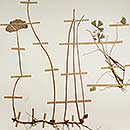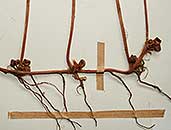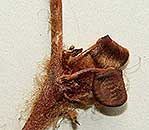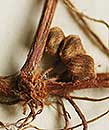Marsilea apposita Launert
Synonyms |
|
|---|---|
Common name |
|
Description |
Floating form: stipe up to 30 cm long, usually hairless. Leaflets up to 26 × 25 mm, broadly obdeltate, outer margin rounded, entire, hairless. Dry land form: stipe up to 8 cm long. Leaflets ± 7 × 5 mm, narrowly obdeltate, outer margins deeply crenate, slightly hairy at beginning. Sporocarps: 3-4 mm long, 2-3.25 mm high, 1.5-2 mm thick, brown, almost rectangular in lateral view, upper side shallowly concave, under side convex, outer side rounded, vertical cross-section narrowly rectangular, continuous shallow groove from upper over outer and along lower side; densely hairy when young becoming hairless with age; inferior tooth a shallow hump or absent, superior tooth rather short, subacute; lateral ribs hardly visible in mature specimens; pedicels up to 8 mm long, cylindrical, wiry, erect or arching, 2 or 3 uniting at the base, sometimes solitary, arising from the axil of the stipe. |
Notes | Recognizable by the prominent upper tooth on the sporocarp, 2 or 3 pedicels uniting at base, sporocarps rectangular outline in vertical cross-section. |
Derivation | apposita: side by side, the pedicels are united in twos or threes at the base giving the sporocarps a closely packed appearance. |
Habitat | Sandy wet soil in river beds, edge of seasonal pools. |
Distribution worldwide | See African distribution. |
Distribution in Africa |
|
Growth form |
Aquatic, terrestrial. |
Literature |
|



